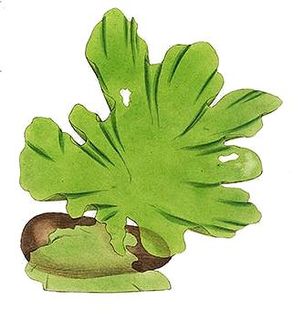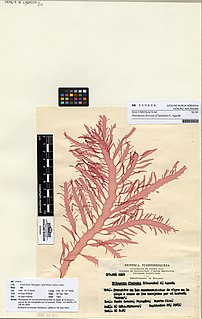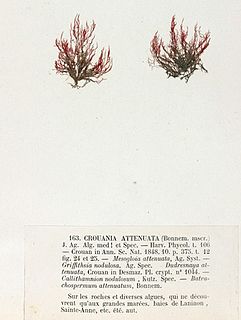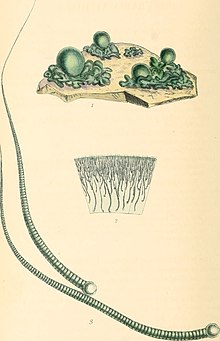
The sea lettuces comprise the genus Ulva, a group of edible green algae that is widely distributed along the coasts of the world's oceans. The type species within the genus Ulva is Ulva lactuca, lactuca being Latin for "lettuce". The genus also includes the species previously classified under the genus Enteromorpha, the former members of which are known under the common name green nori.

Anabaena is a genus of filamentous cyanobacteria that exist as plankton. They are known for nitrogen-fixing abilities, and they form symbiotic relationships with certain plants, such as the mosquito fern. They are one of four genera of cyanobacteria that produce neurotoxins, which are harmful to local wildlife, as well as farm animals and pets. Production of these neurotoxins is assumed to be an input into its symbiotic relationships, protecting the plant from grazing pressure.

Nostoc, also known as star jelly, troll’s butter, spit of moon, fallen star, witch's butter, and witch’s jelly, is the most common genus of cyanobacteria found in various environments that may form colonies composed of filaments of moniliform cells in a gelatinous sheath of polysaccharides. Nostoc is a genus of photosynthetic, Gram-negative cyanobacteria that can be found in both terrestrial and aquatic environments. It may also grow symbiotically within the tissues of plants, providing nitrogen to its host through the action of terminally differentiated cells known as heterocysts. Nostoc is a genus that includes many species that are diverse in morphology, habitat distribution, and ecological function. Nostoc can be found in soil, on moist rocks, at the bottom of lakes and springs, and rarely in marine habitats. It may also be found in terrestrial temperate, desert, tropical, or polar environments.

Oscillatoria is a genus of filamentous cyanobacterium which is often found in freshwater environments, such as hot springs, and appears blue-green. Its name refers to the oscillating motion of its filaments as they slide against each other to position the colony facing a light source. Oscillatoria reproduces by fragmentation, facilitated by dead cells which separate a filament into separate sections, or hormogonia, which then grow. Oscillatoria uses photosynthesis to survive and reproduce. Each filament of oscillatoria consists of trichome which is made up of rows of cells. The tip of the trichome oscillates like a pendulum. In reproduction, it takes place by vegetative means only. Usually the filament breaks into a number of fragments called hormogonia. Each hormogonium consist of one or more cells and grow into a filament by cell division in one direction.

Gracilaria is a genus of red algae (Rhodophyta) notable for its economic importance as an agarophyte, as well as its use as a food for humans and various species of shellfish. Various species within the genus are cultivated among Asia, South America, Africa and Oceania.

Porphyra is a genus of coldwater seaweeds that grow in cold, shallow seawater. More specifically, it belongs to red algae phylum of laver species, comprising approximately 70 species. It grows in the intertidal zone, typically between the upper intertidal zone and the splash zone in cold waters of temperate oceans. In East Asia, it is used to produce the sea vegetable products nori and gim. There are considered to be 60 to 70 species of Porphyra worldwide and seven around Britain and Ireland where it has been traditionally used to produce edible sea vegetables on the Irish Sea coast. The species Porphyra purpurea has one of the largest plastid genomes known, with 251 genes.

Chordariaceae is a family of brown algae. Members of this family are may be filamentous, crustose with fused cells at the base, or they may be terete and differentiated into a central medulla and an outer photosynthetic cortex. They have a sporphytic thallus usually aggregated to form a pseudo-parenchyma.

The Rivulariaceae are a family of cyanobacteria within the Nostocales in which the filaments (trichomes) are tapered from wider at the base to narrower at the tip.

Halymenia a genus of a macroscopic red algae that grows in oceans worldwide. It includes the following species:

Scytonema is a genus of photosynthetic cyanobacteria that contains over 100 species. It grows in filaments that form dark mats. Many species are aquatic and are either free-floating or grow attached to a submerged substrate, while others species grow on terrestrial rocks, wood, soil, or plants. Scytonema is a nitrogen fixer, and can provide fixed nitrogen to the leaves of plants on which it is growing. Some species of Scytonema form a symbiotic relationship with fungi to produce a lichen.
Bangia is an extant genus of division Rhodophyta that grows in marine or freshwater habitats. Bangia has small thalli with rapid growth and high reproductive output, and exhibits behavior characteristic of r-selected species. The plants are attached by down-growing rhizoids, usually in dense purple-black to rust-colored clumps. The chloroplasts of Bangia, like others in the division Rhodophyta, contain chlorophyll a and sometimes chlorophyll d, as well as accessory pigments such as phycobilin pigments and xanthophylls. Depending on the relative proportions of these pigments and the light conditions, the overall color of the plant can range from green to red to purple to grey; however, the red pigment, phycoerythrin, is usually dominant.

Chaetophora elegans is the type species in the algae genus Chaetophora.
Aulosira is a genus of cyanobacteria found in a variety of environmental niches that forms colonies composed of filaments of moniliform cells.
Wollea is a genus of filamentous, heterocystous cyanobacteria that form macroscopic colonies in freshwater habitats. The genus produces akinetes and is known to reproduce with hormogonia.

Nostoc commune is a species of cyanobacterium in the family Nostocaceae. Common names include star jelly, witch's butter, mare's eggs, fah-tsai and facai. It is the type species of the genus Nostoc and is cosmopolitan in distribution.
Maurice-Augustin Gomont was a French phycologist.

Dictyota is a genus of brown seaweed in the family Dictyotaceae. Species are predominantly found in tropical and subtropical seas, and are known to contain numerous chemicals (diterpenes) which have potential medicinal value. As at the end of 2017, some 237 different diterpenes had been identified from across the genus.

Crouania is a genus of red algae (Rhodophyta) in the Callithamniaceae family. The name of the genus honours the French born Crouan brothers, Pierre-Louis Crouan and Hippolyte-Marie Crouan. It was first described by Jacob Georg Agardh in 1842, and the type species is Crouania attenuata.















